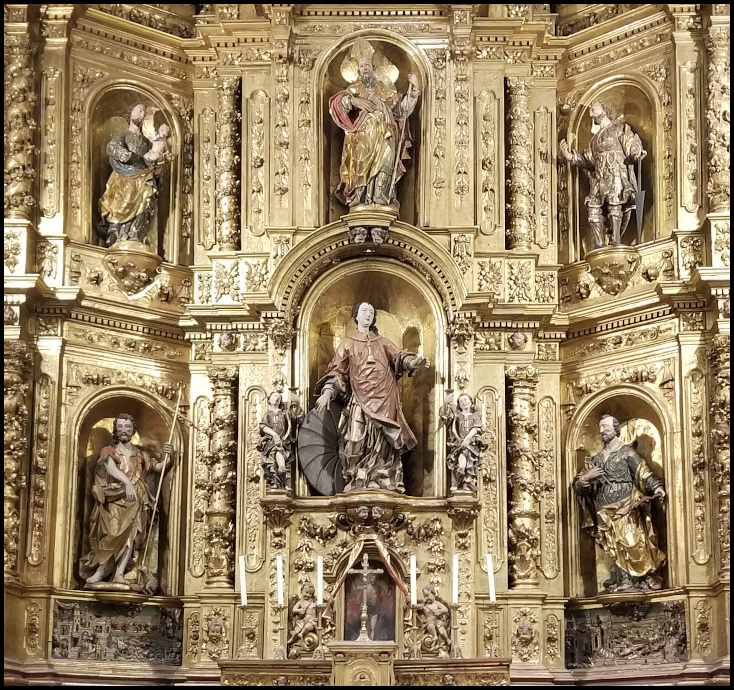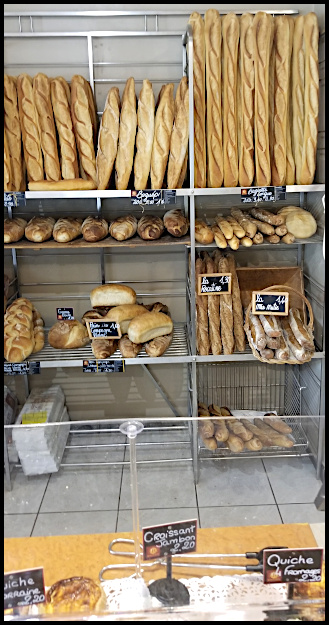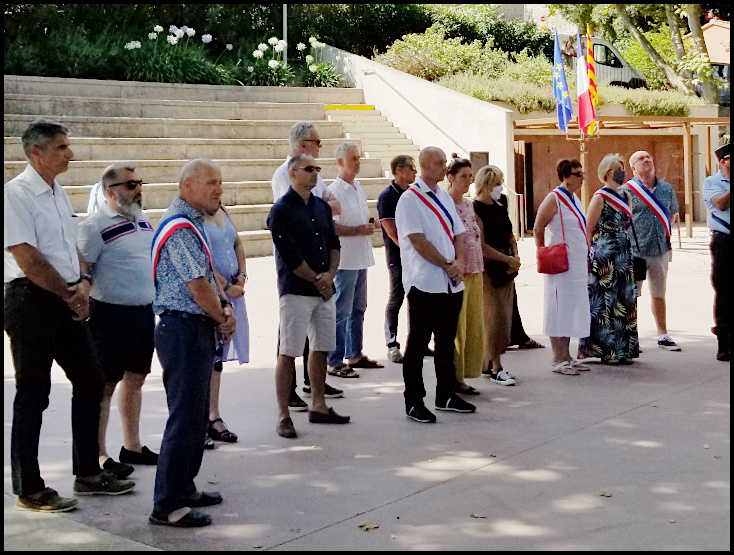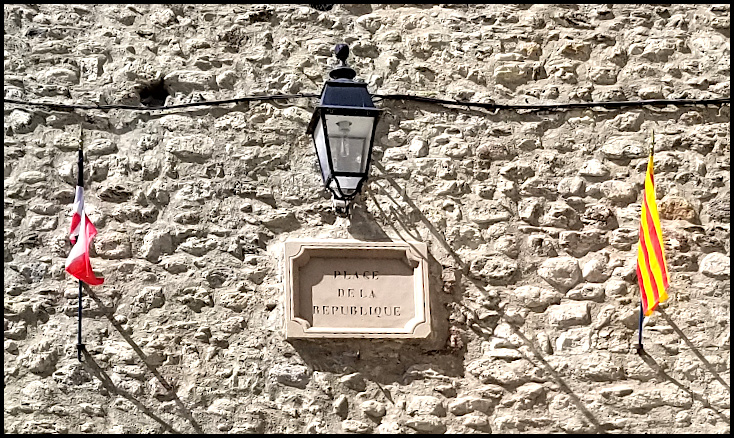See Julie Connor’s July 12, 2022, Between the Covers Live TV interview.
Dennis Carnes | July 20, 2020
Photos by Dennis Carnes
By email and text, our Houston friends, including a doctor, warned us: “Stay! Don’t come home!” News reports, too, were alarming. In Houston, COVID-19 infections were approaching cataclysmic levels. Faced with this disturbing news, my wife Gretchen and I decided to stay in our adopted French village, Laroque des Albères, another month.
This was an easy decision. Laroque is beautiful. Life here is delightful. The town reclines gracefully along the Pyrenees and down to the Mediterranean. The pace of life is slow, and Rocatins, as the town’s residents are called, treasure wholesome foods and fine local wines. We were easily persuaded to stay.
We and some dear friends from Colorado bought our house in Laroque more than 20 years ago. We had toured France looking for a house in a petite village that was near Spain and the Mediterranean and also close to mass transit. In the summer, tens of thousands of French and Northern European tourists, who crave the sun and les plages (the beaches), invade this region during their generous vacations. They flock to towns served by trains, near the beach, and featuring large campgrounds. Thankfully, Laroque is a bit removed from the most popular tourist areas.
Laroque was founded in the 8th century near the early Romanesque Chapel of Our Lady of Tanya, which still exists. You approach the church, which lies just outside the town center, by walking down a lovely road, shaded by cherry trees. Laroque des Albères means “Rock of the Albères,” the Albères being foothills in the Catalan segment of the Pyrenees. Centuries ago, the Visigoths built a castle in the Albères.
In the 1200s, Rocatins relocated their parish church to the Church of St. Felix at its present site on the town’s lovely open square, the Place de la République. St. Felix, the patron saint of Laroque, was martyred in the year 304 when Roman authorities had him drowned with a millstone tied around his neck. He came from the Spanish city of Girona, which Spaniards voted Spain’s most livable city and which lies 45 km. south of Laroque.
The tower of the Church of St. Felix houses two bells. The original bells, installed in the 15th century, were melted down and used to make cannons. Rocatins installed the present ones in the 1800s. However, the most prominent feature of the barrel-vaulted church is not its bells but its magnificent gold retable (altarpiece), carved by Catalan sculptor Josep Sunyer in 1723.

The first King of Majorca, James I, who ruled this region from 1231-1276, used the Church of St. Felix to store arms. In 1285, King James II built a castle in Laroque, where he had fled to escape his brother, who wanted to seize the throne. He connected the castle to the church by an underground passage, which no longer exists, although the door that led to it is still there. Today, only fragments of the castle remain, although the village has restored the castle keep, which rises over the town like an exclamation point, reminding everyone of Laroque’s rich history. Walk up to the keep and you’ll be rewarded with a marvelous view of nearby villages and a dark-blue strip of the Mediterranean.
Let’s return to the center of Laroque. The Romans introduced plane trees to Gaul (now France) in the 1st century, and a majestic plane tree anchors the east end of the Place de la République. To me, this tree, which Rocatins planted in 1830 to celebrate the abdication of King Charles X, symbolizes Laroque more than anything else in the village.
As I stroll through our Wednesday market, now held near the shops in the main part of town, I recall that the market in Laroque, which has existed for hundreds of years, used to be held in the Place de la République. The ancient market must have been similar to today’s. Vendors would have sold textiles, clothes, cheese, and fruits and vegetables just as they do now. Vegetables from the New World, such as tomatoes, would have been missing, but the experience would have been very similar. Today, Rocatins hold many festivals in the Place de la République. My favorite is the fete du chocolat (chocolate festival).
Fewer tourists have come to Laroque this year than in the past, undoubtedly because of COVID-19. These tourists are mainly French, along with a few Belgians and Germans. Café owners depend on summer tourists to make their yearly profits, hiring additional servers in the summer and doing business every day and for longer hours. When tourists leave in the autumn, the cafés close for several months. To reduce our exposure to the virus, we’re avoiding the cafés this year. COVID-19 hasn’t yet reached Laroque, but with all the tourists here, why take a chance?
Côté Saisons, the one restaurant we do frequent, is the exception. Co–owner Ingrid, who speaks both French and English, says the best translation of Côté Saisons is “Follow the Seasons.” Every year, Ingrid and her husband, Nicholas—once a chef at the Plaza Hotel in Paris—earn Michelin recognition for their food and service. Staff at Côté Saisons wipe down and disinfect the menus, tables, and chairs after every use. We sit on the patio, where the tables are far apart and most diners wear masks. Serving in a French restaurant is a respected vocation, not something people do while they’re waiting for their lives to begin. The excellent servers at Côté Saisons don’t hover near their guests but quietly appear when needed or when bearing the delights Nicholas has prepared for us.

Every morning I walk to many of Laroque’s small shops. Join me! We’ll walk down the residential Rue Francois Arago, named after François Arago, the early 19th century astronomer, physicist, and philosopher. In the Middle Ages the same street was called Rue de l’Hôpital (Hospital Street), because monks had established a hospital here to serve townspeople and pilgrims traveling along the route of Saint Jacques de Compostelle. Sometime after 1371, the old hospital was divided into houses. Along this route is Number 17 (just around the corner from our house) where, in the 1800s, a mill produced flour and oil.
On our left, we walk by a house that displays a box of books, free for the taking. Ninety-nine percent of French people are literate. The French—who don’t revere wealth and consider it rude to ask “What do you do?”—admire those who are well-read and speak and write well.
As we continue on, we pass by Casa Lilli, a small bar and restaurant owned by Lilli and her husband, Andre. We wave and say “Bonjour ” to Andre and his guest Nico, who is enjoying a morning coffee. Nico, who is also our friend as well as an accomplished contractor, has done excellent work on our house. Normally, we would make reservations for one of Lilli’s scrumptious dinners, but we can’t this year. It’s impossible to maintain social distancing inside tiny Casa Lilli.
Farther down is Café Carignan, where folks sit on the patio and enjoy a coffee, a glass of wine, or a good Belgian beer.
Now we come to Café des Artistes, owned and operated by Fearghal, an Irishman and rugby fanatic, and his English wife, Melanie. Their daughter Mia helps out and their dog Finn sleeps in the doorway. Locals say Café des Artistes has the best terrace in France.
Across the street is Le Terrible Enfant (The Terrible Child), formerly Le Palmiers restaurant. The Belgian couple who ran Les Palmiers earned a Michelin star, and we always made a point of splurging for a magnificent dinner there. The Belgians, however, couldn’t make a go of it and eventually returned home.
Next, we stop at le boulangerie (the bakery) for a freshly baked baguette and two croissants a’ beurre (croissants with butter). The bakery also offers croissants a’ natural—but those are best given to your pets! Celine or her colleague Sarah see me waiting outside, wearing my tight, black gloves and my mask, waiting patiently for my turn to enter. When I go in, my goodies are gathered and waiting. We greet each other with “Bonjour, ça va? ” (Good morning, how’s it going?). I put down €4 (about $4.50) and slide my baguette, croissants, and L’ Independent (the regional daily newspaper) into my backpack with a “Merci, a’ bientot! ” (Thanks, see you soon!) or a “Merci, a’ demain! ” (Thanks, see you tomorrow!). They return a “Bon journée! ” (Have a good day!).

Depending on what we want for lunch, we might also stop at la boucherie (the butcher shop). The clerk, Murielle—who kindly tolerates my bad French—infers my needs from my shopping list. Although Americans tend to think the French are rude, they are actually very polite! Americans misinterpret the quiet, less demonstrative French manner.
Now let’s pop into l’ epicerie (the grocery store), for fresh fruit, vegetables, and herbs. The very pleasant Darice and her employee Virginie might drop something they think is particularly good that day into my bag. No matter how vehemently I protest, they’ll refuse to charge me for the lagniappe. Their coworker Julien offers to carry the bags to our house, but I thank him and decline.
My wife, Gretchen, prefers the local wine, Les Vignerons Albères, supplied by the cooperative in St. Genis. For Les Vignerons Albères, winemakers blend juice from Carignan, Grenache, and Syrah grapes, creating a mild wine that you can drink with your meal, as an apéritif, or just enjoy in the evening. When it gets hot, as it is now, Rocatins drink their vin rouge (red wine) chilled, or they switch to vin rosé. We buy boxed wine for €3 a liter (about $3.50) at the Proxi, our small grocery store, where you can also take your own bottle to fill for even less.
On the way back home, we run into our friend Pierre, fit, square jawed, broad shouldered, lean, and erect. Pierre, whom we’ve known for 20 years, never seems to age. It is the same for his mother, who lives up by the castle keep.
We continue our walk, now under flags and pennants the villagers have strung over the streets in honor of la Fête Nationale (Bastille Day), which is July 14. The French stormed the Bastille prison in Paris on July 14, 1789, igniting the revolution against the monarchy. In Paris, this year they celebrated the day with solemn ceremonies, military parades, and special honors for medical workers. Parisians gathered in the Place de la Concorde, which Ange Jacques Gabriel, King Louis XV’s architect, designed in 1755. In 1793, revolutionaries executed King Louis XVI in the very same Place de la Concorde.
This year Laroque also held a Bastille Day celebration. Nearly 100 people gathered in the Theatre de Verdure (Theater of Greenery), an open-air amphitheater below the shops. Members of the village council, among them our neighbor Christine, stood in front as our mayor spoke about our freedoms and history and awarded a medal to a woman who makes masks for those who can’t afford them.

More Catalan red-and-yellow flags fly in Laroque than French tricolor flags. In the 9th century, Charlemagne created the County of Barcelona to defend against the Muslims. In the 12th century, Barcelona merged with the Kingdom of Aragon to create Catalonia, which includes northeast Spain and our part of France. Some Rocatins speak Catalan. The new French Prime Minister, Jean Castex, is a Catalan from Prades, which is 74 km. west of Laroque.

When we return to Houston, we’ll miss Laroque and its inhabitants. I will think often of life here, of its beauty, and of the kind and gentle people who have lived here with grace and elegance for centuries.
— Email comments to Julie@bayoucitypress.com or leave public comments below.
Contact us if your comment or reply won’t post.
See Julie Connor’s July 12, 2022, Between the Covers Live TV interview.
Read Carrie Carter’s July 6, 2022, interview on the Crazy for Words blog.



